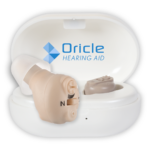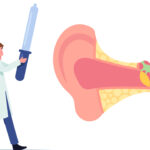Sensorineural Hearing Loss: Comprehensive Guide, Causes, and Treatment Options
What is Sensorineural Hearing Loss (SNHL)?
Sensorineural hearing loss, also known as nerve-related hearing loss, occurs when the hair cells within the inner ear or the auditory nerve are damaged. The inner ear contains tiny hair cells that pick up sound vibrations and send signals to the brain through the auditory nerve. When these hair cells or the nerve is damaged, it affects the person's ability to hear properly.
SNHL can range from mild to profound, depending on the extent of the damage. It can affect one or both ears and in some cases, it may worsen over time. SNHL can be congenital, meaning present at birth, or acquired later in life.
Causes of Sensorineural Hearing Loss

There are several factors that can cause sensorineural hearing loss. Some of the most common causes include:
1. Aging (Presbycusis)
As people age, the hair cells in the inner ear gradually deteriorate, leading to a decline in hearing ability. This age-related hearing loss is called presbycusis.
2. Noise-induced hearing loss
Loud noises, such as those from heavy machinery, concerts, or firearms, can damage the hair cells in the inner ear, leading to permanent hearing loss.
3. Genetic factors
Some individuals inherit genes that make them more susceptible to sensorineural hearing loss.
4. Illnesses and infections
Certain viral or bacterial infections, such as meningitis or measles, can damage the inner ear and cause hearing loss.
5. Head injuries
Trauma to the head can result in damage to the inner ear or the auditory nerve.
6. Ototoxic medications
Some medications, including certain antibiotics, chemotherapy drugs, and diuretics, can damage the inner ear and lead to hearing loss.
7. Autoimmune diseases
Conditions like lupus or rheumatoid arthritis can cause inflammation in the inner ear, resulting in hearing loss.
Symptoms of Sensorineural Hearing Loss
Common symptoms of sensorineural hearing loss include:
1. Difficulty understanding speech, particularly in noisy environments
2. Muffled or distorted sounds
3. Tinnitus (ringing in the ears)
4. Difficulty hearing high-pitched sounds
5. Difficulty hearing on the telephone
6. Needing to turn up the volume on the television or radio
Diagnosing Sensorineural Hearing Loss
If you suspect you have sensorineural hearing loss, it is essential to consult with an audiologist or a healthcare professional specializing in hearing health. They will conduct a series of tests, including:
1. Pure-tone audiometry test
This test measures your ability to hear different frequencies of sound at various volumes. It helps determine the degree and type of hearing loss.
2. Speech audiometry test
This test measures your ability to understand speech at various volumes and in different environments, such as with or without background noise.
3. Tympanometry
This test measures the movement of the eardrum in response to changes in air pressure. It helps identify any issues with the middle ear, which may contribute to hearing loss.
4. Otoacoustic emissions (OAE) test
This test measures the sounds generated by the hair cells in the inner ear in response to sound stimuli. It can detect damage to the hair cells, even in the early stages.
5. Auditory brainstem response (ABR) test
This test measures the electrical activity of the auditory nerve and the auditory pathway in the brainstem. It helps determine if the hearing loss is due to damage in the auditory nerve or the brain.
Treatment Options for Sensorineural Hearing Loss

While sensorineural hearing loss is often permanent, various treatment options can help improve hearing ability and overall quality of life. These include:
1. Hearing aids
Hearing aids are electronic devices that amplify sounds, making it easier for individuals with hearing loss to understand speech and other sounds. There are various styles and technologies available to suit different needs and preferences.
2. Cochlear implants
Cochlear implants are surgically implanted devices that bypass damaged hair cells in the inner ear and directly stimulate the auditory nerve. They are typically recommended for individuals with severe to profound sensorineural hearing loss who do not benefit from hearing aids.
3. Assistive listening devices (ALDs)
ALDs, such as FM systems, infrared systems, or induction loop systems, can help individuals with hearing loss better understand speech in challenging listening environments, like noisy restaurants or classrooms.
4. Bone-anchored hearing systems (BAHS)
BAHS are surgically implanted devices that transmit sound vibrations through the skull directly to the inner ear, bypassing the outer and middle ear. They are typically recommended for individuals with conductive or mixed hearing loss, but in some cases, they can also benefit those with sensorineural hearing loss.
5. Tinnitus management
For individuals with tinnitus, various strategies, such as sound therapy, counseling, and relaxation techniques, can help manage the symptoms.
Coping Strategies and Support for Sensorineural Hearing Loss
Living with sensorineural hearing loss can be challenging, but there are several coping strategies and resources available to help individuals manage their condition effectively:
1. Communication Strategies
Using visual cues, like lip-reading or sign language, can aid communication. Additionally, ensure that you face the person you are speaking with and minimize background noise.
2. Support Groups
Joining a local or online support group can provide emotional support and practical advice from others who share similar experiences.
3. Education and Advocacy
Educate yourself about your condition and advocate for your needs, such as requesting accommodations in the workplace or public spaces.
Conclusion
Sensorineural hearing loss is a prevalent condition with various causes, ranging from aging to genetic factors. Early diagnosis and appropriate treatment options, such as hearing aids or cochlear implants, can significantly improve hearing ability and overall quality of life. Coping strategies, support groups, and self-advocacy are essential components of living well with sensorineural hearing loss. By understanding this condition and seeking the right support, individuals can continue to lead fulfilling lives.
Sources
- World Health Organization. (2021). Deafness and hearing loss. https://www.who.int/news-room/fact-sheets/detail/deafness-and-hearing-loss
- American Speech-Language-Hearing Association (ASHA). (2021). Sensorineural hearing loss. https://www.asha.org/public/hearing/sensorineural-hearing-loss/
- Hearing Loss Association of America (HLAA). (2021). Types of hearing loss. https://www.hearingloss.org/hearing-help/hearing-loss-basics/types-causes-and-treatment/







